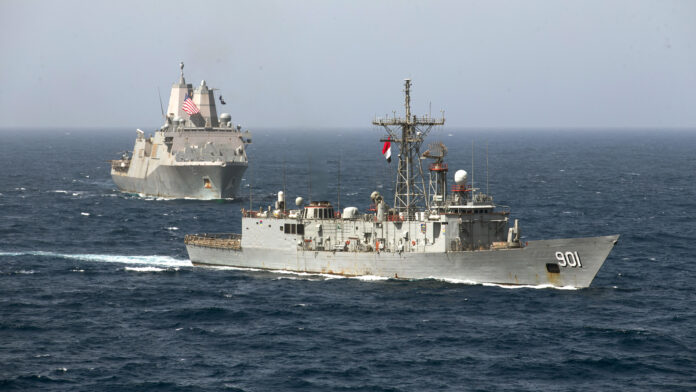The Egyptian guided-missile frigate ENS Sharm El-Sheikh (FFG 901) and the U.S. amphibious transport dock ship USS Somerset (LPD 25) conducted a passing exercise (PASSEX), March 14, the U.S. Navy announced.
A PASSEX is an exercise where multiple ships operate in close vicinity to practice evolutions together to improve crews’ knowledge, navigation, and interoperability.
“Operating with the Egyptian Navy is a highlight for our deployment. As the U.S. Navy operates forward to reassure friends and deter adversaries, strengthening partnerships is important,” said Capt. Dave Kurtz, Somerset’s commanding officer.
The PASSEX commenced with Sharm El-Sheikh and Somerset performing divisional tactics and maneuvers in a formation. Additionally, the ships served replenishment-at-sea approaches to strengthen our ability to operate together and increase ship-handling skills.
“Our work with the Egyptians was coordinated in detail and took advantage of common maritime operating procedures,” said Kurtz. Although brief, it solidifies that our two navies can and often do operate from the same playbook. By capturing those lessons, the following exercise can build on that foundation and become even more complex.”
Somerset is deployed to the U.S. 5th Fleet area of operations to support naval operations to ensure maritime stability and security in the Central region, connecting the Mediterranean and the Pacific through the western Indian Ocean and three strategic choke points.

USS Somerset (LPD-25):
USS Somerset (LPD-25) is a San Antonio-class amphibious transport dock of the United States Navy. Somerset is the fourth Navy vessel, and the second warship to bear the name; the first two being a wooden-hulled motorboat and a ferry.
USS Somerset is 208 meters long and has 25.300 tonnes displacement. She has four sequentially turbocharged marine Colt-Pielstick diesel engines, two shafts, 41,600 shp. Her maximum speed is 22 knots.
The ship was designed to provide the Navy and U.S. Marine Corps with modern, sea-based platforms that are networked, survivable, and built to operate with 21st century transformational platforms, such as the MV-22 Osprey, the (since canceled) Expeditionary Fighting Vehicle (EFV), air-cushioned landing craft (LCACs), and future means by which marines are delivered ashore.
USS Somerset has significant survivability features and computer technology. In addition to Rolling Airframe Missile (RAM) protection from air threats, the class was designed to minimize radar signature. Techniques that reduce radar cross-section (RCS) make the ships more difficult to locate and target.
The San Antonio-class also incorporates the latest quality of life standards for the embarked Marines and sailors, including sit-up berths, a ship services mall, a learning resource center, and a fitness center. Medical facilities include two operating rooms and 124 beds.

To learn more about San Antonio-class LPDs you can check out Naval Library app.



